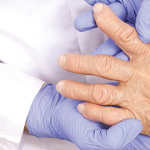One tool developed for this group is EULAR’s Symptoms in Persons at Risk of Rheumatoid Arthritis questionnaire, which attempts to systematically paint a picture of a patient’s total symptom experience with arthralgia.5
“I suspect it will be an important tool for us to try and understand whether there are symptoms that you can perhaps get GPs to start pinpointing, so they know who to refer to us,” Dr. Raza said.
‘If you tell people that they’re at increased risk & why they’re at increased risk, then they’re encouraged to change their behavior to reduce their risk,’ Dr. Raza said.
Environmental & Lifestyle Factors
A study on the ability of autoantibody tests to ascertain risk in those with clinically suspect arthralgia found that such tests do not make a definitive prediction. Researchers said the “presence of ACPA and RF is insufficient for accurately identifying imminent ACPA-positive RA. They found a third of patients with clinically suspect arthralgia and who are ACPA and RF positive still won’t progress to RA.6
An expanding area of literature, Dr. Raza said, has been exploration of environmental factors that could be modulating the immune system and affecting whether patients do or do not progress from one risk phase to the next.
In one study, patients who were ACPA positive but without RA at baseline, but later developed RA, were found to have lower levels of the omega-3 fatty acid, docosapentaenoic acid (DCPA).7
“I think this is an example of a paper [that] will show the measurement of environmental factors like this will help us predict RA progression over time,” he said.
Anti-CCP antibodies in the sputum also might offer a clue to the chances of RA progression. A study earlier this year found that levels of the autoantibodies were higher among those at a high risk of RA.
Importantly, this sometimes matched with the equivalent antibody in the blood, but sometimes it didn’t.8
“As we getting earlier and earlier toward when immune tolerance is broken and when disease begins from an immunological perspective, we need to think about looking at autoantibodies in other places besides the blood,” Dr. Raza said.
Still more research has found that lifestyle changes appear to be more likely if the risk is presented to patients in a certain way. A study of those with first-degree relatives with RA were told what their lowest possible risk was, based on unmodifiable factors, such as age and their close relationship with an RA patient. And they were told what their modifiable risk, based on such factors as diet and smoking, was. These patients were more likely to want to make lifestyle changes.9


